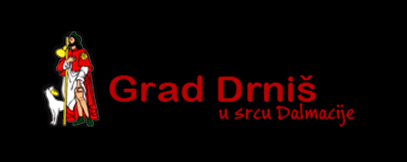
August 29, 2020 – Hidden Dalmatia returns to the hinterland and there, the historic hillside town of Drniš has plenty to shout about, not least the best prosciutto in Croatia and world-famous sculptor Ivan Meštrović.
It can be hard to explain the Bura to summertime visitors. They bask in the sunshine, swim in the crystal-clear Adriatic and feast on the best seafood, meats, fruits and vegetables given up by the idyllic-looking land which surrounds them. They rarely stay in Dalmatia long enough to experience the autumn and winter months, when the body-bracing Bura comes into play.

It's easier to explain the Bura to those who see the at times alien-looking surface of island Pag - long stretches of rock, scorched until near barren, stripped of all but the hardiest vegetation by this intense, seasonal wind and the corrosive layer of sea salt it lifts onto the surface. There's less evidence of this force of nature within the lush, green surroundings of Drniš, a town perched in the hills of the Dalmatian hinterland, just 30 kilometres behind Šibenik. Yet it is these winds, along with its singular, sub-Mediterranean micro-climate, that lend the town's famous Drniš prosciutto (Drniški pršut) its unique flavour.

Found less frequently by visitors than it deserves, the town of Drniš is nevertheless not unrecognised. It is known as the childhood home of Croatia's most famous sculptor, Ivan Meštrović and the town museum holds many of his works. And of all the wonderful prosciutto produced in Croatia, only four types are protected at an EU-level, under their distinct place of origin. That produced in Drniš is one of them.
The winds that attack Drniš and its settlements come from almost every direction, just like the numerous invading forces – Turks, Italians, French, Habsburgs, Venetians, even the Yugoslavian National Army - who have previously stormed the town. From Velebit and the Dinaric Alps comes the cold Bura, from the Adriatic, the warmer Mistral (or Donjak). The force of wind can be very strong, although the houses and vegetation are used to withstanding such. The devastation left by the aforementioned armies has been considerably worse – Drniš has been rebuilt several times, and visible scars remain.

The remnants of former fortifications, one of the town's many scars © Croatian National Tourist Board
Like the homes, flora and people of Drniš, there's a necessary resilience to the animals which also live here. The two most famous domesticated sorts are sheep and pigs. Animal husbandry is one of the oldest-known occupations of the residents of this settlement – indeed there are traces of pig farming in the region that date back to 1500 years B.C. Though less famous than the lamb from Lika or Pag, that which comes from Drniš is a rare and spectacular treat. But, Drniš sheep are traditionally more renowned for their milk.
This is no place for cows. Nor is anywhere close by. For centuries, the local cheese-making tradition was instead reliant on sheep's milk. The yield of milk from these animals is not great, nor can it be taken when needed for freshly arrived lambs. So, what little could be collected was preserved as cheese inside sheep skin. Fermented in these conditions for several months, the process lends the cheese a full and highly distinctive taste. It is subsequently more than able to stand up to the strong flavours of the smoked prosciutto, punchy red wines and crusty, artisan breads with which it's often served.

Dalmatian cheese, stored in sheep skin (Sir iz mišine) © Croatian National Tourist Board
These days, improved transportation means you can get cow's milk everywhere. But, so popular is this method of preservation and the special flavour it imparts, that these same sheep skins are nowadays also used to make a slightly milder cow's milk version of this famous Dalmatian cheese (Sir iz mišine).
More picky with their diet than the pigs raised here, sheep from Drniš must be taken into the hills to graze. There, the hardy animals feast on the wild grasses, herbs and flowers found between rocks on the terrain. Foraging alongside them in days of old, the accompanying shepherds must have been just as hardy. Over 100 years ago, one such shepherd was the father of Croatia's most famous sculptor, Ivan Meštrović. Though just a peasant, he was the only literate man in the village of Otavice, just outside Drniš, although family reading was restricted to the one book they owned - the Bible. It was from this book that his son, Ivan Meštrović learned to read and write, Ivan's mother reciting its stories and guidance every night from memory. As a boy, Ivan would follow his father to tend the sheep and would hear epic song-poems of heroic history and myth ring out around the hills.

Ivan Meštrović © Archive of Ivan Meštrović Museum
Both of these educations would later inspire his work, but not until he first walked from Drniš to Split aged sixteen to begin an apprenticeship as a stonemason. It was to be the first step on a path that would see him become the pre-eminent sculptor of his era. His works help define the cities of Split, Chicago, Belgrade and Zagreb, with several also residing in Drniš streets.

'The Ploughmen' © Roberta F

'Vrelo Života' in Drniš © Roberta F
These include a relief called 'Orači (Ploughmen)', another of St. Roko, a statue, 'Mother and Child', a well-positioned drinking fountain called 'Vrelo Života (Source of Life)' and the Church of the Holy Redeemer in Ružić, near Otavice, where he, his mother and father rest. There are a further 50 Meštrović pieces residing in Drniš City Museum, many of them, like the building itself, a gift to the town from former mayor, Nikola Adžija (1875 – 1972).

'Mother and Child' © Roberta F

'St Roko' i© Roberta F
Before Meštrović set ties between Drniš and Split in stone, that link had actually already been made. The town was connected to the city, and to Šibenik, in 1877 by one of Croatia's first railways, built to transport rocks and the results of mining from the area of Drniš. Today, on a smaller scale, the descendants of that industry remain, supplying stone and building materials. However, the export of prosciutto is now much better known.

© Tourist Board of Drniš
So renowned is Drniš prosciutto that the locale cannot produce enough pigs for the demand. But, as it is the process of preserving and the micro-climate than grants the distinction, fresh pig meat is brought from outside to bolster production. After slaughter, the meat of Drniš prosciutto must be shaped and coated in sea salt within no more than 72 hours. It then sits for 7-10 days, depending on the weight, then pressed for 15-20 days. Afterward comes the smoking.
Dalmatian prosciutto is the other protected Croatian variety that is smoked. However, birch, beech and oak are the woods used in this process - in Drniš they use immortelle and almond. After smoking, it is air-dried and matured for one to two years.

© Tourist Board of Drniš
Records of prosciutto production in the area may stretch back to the 14th century, but that from Drniš only became a known market brand in the mid 20th century. Indeed, Drniš prosciutto was served at the Coronation of Queen Elizabeth II in 1952 (and a gift of the same, sent to her in 2002 to celebrate her 50 years on the throne). Production of prosciutto in Drniš hit a peak at around this time but, gradually, other regions stepped ahead and became better known. They were simply better able to market themselves than inland Drniš, assisted by their seaside location and frequent visitors.

© Tourist Board of Drniš
That has thankfully been redressed since the EU designation was awarded and the intense ruby-red ham of Drniš is justly receiving a revival. Since 2013 it has been celebrated annually in late August at the town's International Prosciutto Festival, where its shiny, thin strips of sweet and aromatic meat are paired with traditional Dalmatian sides and assessed next to prosciutto from all over Europe.
The Drniš wind orchestra, klapa singers and tamburica players entertain at the festival, joined by visitors in raising a riotous toast to Drniš's fabulous pršut. As well they should. For although slightly off the beaten track, with Ivan Meštrović and this distinct prosciutto as strings to their bow, the town of Drniš has plenty to shout about.

The Church of the Most Holy Redeemer, the last resting place of Ivan Meštrović and family, in Otavice, near Drniš © Zrno
SOURCE: www.total-croatia-news.com
The winds that attack Drniš and its settlements come from almost every direction, just like the numerous invading forces – Turks, Italians, French, Habsburgs, Venetians, even the Yugoslavian National Army - who have previously stormed the town. From Velebit and the Dinaric Alps comes the cold Bura, from the Adriatic, the warmer Mistral (or Donjak). The force of wind can be very strong, although the houses and vegetation are used to withstanding such. The devastation left by the aforementioned armies has been considerably worse – Drniš has been rebuilt several times, and visible scars remain.

The remnants of former fortifications, one of the town's many scars © Croatian National Tourist Board
Like the homes, flora and people of Drniš, there's a necessary resilience to the animals which also live here. The two most famous domesticated sorts are sheep and pigs. Animal husbandry is one of the oldest-known occupations of the residents of this settlement – indeed there are traces of pig farming in the region that date back to 1500 years B.C. Though less famous than the lamb from Lika or Pag, that which comes from Drniš is a rare and spectacular treat. But, Drniš sheep are traditionally more renowned for their milk.
This is no place for cows. Nor is anywhere close by. For centuries, the local cheese-making tradition was instead reliant on sheep's milk. The yield of milk from these animals is not great, nor can it be taken when needed for freshly arrived lambs. So, what little could be collected was preserved as cheese inside sheep skin. Fermented in these conditions for several months, the process lends the cheese a full and highly distinctive taste. It is subsequently more than able to stand up to the strong flavours of the smoked prosciutto, punchy red wines and crusty, artisan breads with which it's often served.

Dalmatian cheese, stored in sheep skin (Sir iz mišine) © Croatian National Tourist Board
These days, improved transportation means you can get cow's milk everywhere. But, so popular is this method of preservation and the special flavour it imparts, that these same sheep skins are nowadays also used to make a slightly milder cow's milk version of this famous Dalmatian cheese (Sir iz mišine).
More picky with their diet than the pigs raised here, sheep from Drniš must be taken into the hills to graze. There, the hardy animals feast on the wild grasses, herbs and flowers found between rocks on the terrain. Foraging alongside them in days of old, the accompanying shepherds must have been just as hardy. Over 100 years ago, one such shepherd was the father of Croatia's most famous sculptor, Ivan Meštrović. Though just a peasant, he was the only literate man in the village of Otavice, just outside Drniš, although family reading was restricted to the one book they owned - the Bible. It was from this book that his son, Ivan Meštrović learned to read and write, Ivan's mother reciting its stories and guidance every night from memory. As a boy, Ivan would follow his father to tend the sheep and would hear epic song-poems of heroic history and myth ring out around the hills.

Ivan Meštrović © Archive of Ivan Meštrović Museum
Both of these educations would later inspire his work, but not until he first walked from Drniš to Split aged sixteen to begin an apprenticeship as a stonemason. It was to be the first step on a path that would see him become the pre-eminent sculptor of his era. His works help define the cities of Split, Chicago, Belgrade and Zagreb, with several also residing in Drniš streets.

'The Ploughmen' © Roberta F

'Vrelo Života' in Drniš © Roberta F
These include a relief called 'Orači (Ploughmen)', another of St. Roko, a statue, 'Mother and Child', a well-positioned drinking fountain called 'Vrelo Života (Source of Life)' and the Church of the Holy Redeemer in Ružić, near Otavice, where he, his mother and father rest. There are a further 50 Meštrović pieces residing in Drniš City Museum, many of them, like the building itself, a gift to the town from former mayor, Nikola Adžija (1875 – 1972).

'Mother and Child' © Roberta F

'St Roko' i© Roberta F
Before Meštrović set ties between Drniš and Split in stone, that link had actually already been made. The town was connected to the city, and to Šibenik, in 1877 by one of Croatia's first railways, built to transport rocks and the results of mining from the area of Drniš. Today, on a smaller scale, the descendants of that industry remain, supplying stone and building materials. However, the export of prosciutto is now much better known.

© Tourist Board of Drniš
So renowned is Drniš prosciutto that the locale cannot produce enough pigs for the demand. But, as it is the process of preserving and the micro-climate than grants the distinction, fresh pig meat is brought from outside to bolster production. After slaughter, the meat of Drniš prosciutto must be shaped and coated in sea salt within no more than 72 hours. It then sits for 7-10 days, depending on the weight, then pressed for 15-20 days. Afterward comes the smoking.
Dalmatian prosciutto is the other protected Croatian variety that is smoked. However, birch, beech and oak are the woods used in this process - in Drniš they use immortelle and almond. After smoking, it is air-dried and matured for one to two years.

© Tourist Board of Drniš
Records of prosciutto production in the area may stretch back to the 14th century, but that from Drniš only became a known market brand in the mid 20th century. Indeed, Drniš prosciutto was served at the Coronation of Queen Elizabeth II in 1952 (and a gift of the same, sent to her in 2002 to celebrate her 50 years on the throne). Production of prosciutto in Drniš hit a peak at around this time but, gradually, other regions stepped ahead and became better known. They were simply better able to market themselves than inland Drniš, assisted by their seaside location and frequent visitors.

© Tourist Board of Drniš
That has thankfully been redressed since the EU designation was awarded and the intense ruby-red ham of Drniš is justly receiving a revival. Since 2013 it has been celebrated annually in late August at the town's International Prosciutto Festival, where its shiny, thin strips of sweet and aromatic meat are paired with traditional Dalmatian sides and assessed next to prosciutto from all over Europe.
The Drniš wind orchestra, klapa singers and tamburica players entertain at the festival, joined by visitors in raising a riotous toast to Drniš's fabulous pršut. As well they should. For although slightly off the beaten track, with Ivan Meštrović and this distinct prosciutto as strings to their bow, the town of Drniš has plenty to shout about.

The Church of the Most Holy Redeemer, the last resting place of Ivan Meštrović and family, in Otavice, near Drniš © Zrno
SOURCE: www.total-croatia-news.com















